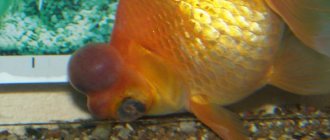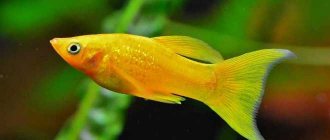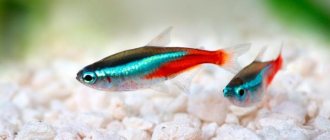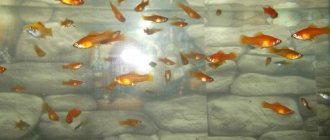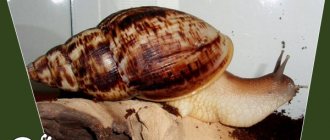Many lovers of beauty would like to have a goldfish, like in a fairy tale, which would also be able to make wishes come true. But, unfortunately, we are not in a fairy tale.
And today we will talk about an ordinary aquarium fish from a subspecies of freshwater crucian carp.
In nature, there are various types of these fabulous fish with different sizes, shapes and colors, so you can choose one for every taste. Goldfish in all their splendor are shown in the photo. Before making your final choice, you should carefully consider all the nuances.
Goldfish were the first of the faunal inhabitants to appear as pets among people.
At first they were brown in color, but over time, as a result of repeated selections, light red-colored species appeared. Today there are many varieties of golden beauties, of all sizes and colors.
COMET
One of the fish included in the so-called “Goldfish” family. The fish is unusual and very beautiful.
The comet's body is elongated with a long, ribbon-like, forked caudal fin. The higher the assessment of a fish specimen, the longer its caudal fin. Comets are very similar to veiltails.
The color options for the comet are different. Of particular value are individuals whose body color is different from the color of their fins. The main color of the body is red-orange with the occasional presence of white and yellow. The color of the fish is affected by the degree of lighting in the aquarium and the food. The best way to maintain the original colors of the comet goldfish is with fresh food, good lighting and the presence of shaded areas in the aquarium. The length of the fish is up to 18 cm, life expectancy is about 14 years.
Groups
With the constant increase in varieties of aquarium pets, it became necessary to classify them. All breeds were grouped according to external characteristics.
Goldfish are conventionally divided into two large groups:
- Long-bodied. Their body shape resembles their ancestor, the crucian carp. They are characterized by increased mobility, are more resilient, live longer, and have less need for oxygen. Some specimens with long bodies can live up to 40 years.
- Short-bodied. These fish are less hardy and require more water than long-bodied fish of equal size. Life expectancy (even if all conditions of detention are met) is less - no more than 15 years.
In the homeland of goldfish (in China) there is its own (more detailed) classification:
- By color. Grey, black, red, yellow, white, spotted, blue, purple, speckled.
- According to body shape. Long and narrow or short and round.
- Along the caudal fin. There are fish with a simple, forked, hanging, or enlarged triple tail. There are also representatives with a simple upper and forked lower caudal fin.
- Along the dorsal fin. Fish come with normal, vestigial, long, short fins, or without them at all.
- Along the anal fin. Similar to a dorsal outgrowth. There are simple, forked, rudimentary, long, short. There are fish without fins, and also with different ones - simple at the top, forked at the bottom.
- According to the shape of the head. Normal, narrow, wide, lion, goose.
- According to the shape of the eyes. Representatives are divided into breeds with small, normal, “dragon”, “sky eye” and “water eyes”.
- By scales. There are specimens with normal opaque, transparent, pearlescent, without body covering.
VAKIN
For a vakin you will need a large aquarium, at least 80 liters for two fish. Goldfish are very sensitive to a lack of oxygen, so aeration in the reservoir must be present, and also equip the aquarium with a filter. Temperature conditions can vary from 18 to 22 degrees, hardness - up to 25, pH - 5.0-8.0. It is better to choose light soil, you can use small pebbles or sand, dim lighting from above.
The wakina is fed with both live and dry food, regularly give it vegetable supplements, but do not overfeed. The first signs of overeating fish are that it begins to swim on its side and becomes lethargic; in this case, the diet is reduced and fasting days are arranged.
Fish nutrition
The fish should be fed little by little 1-2 times a day so that everything is absorbed within 10 minutes, no more. Avoid overfeeding, as this can cause the fish to get sick.
Provide your fish with a variety of food, as they are omnivores. First dilute dry food a little with water, and defrost frozen food to room temperature and you can feed the fish.
Do not re-freeze! Live aquarium plants should also be present in the form of food, and not just decoration.
- Silver carp - fish characteristics, habitats, fishing and bait features + 80 photos
Pike perch - characteristics of the species, seasonality of catch, feeding and spawning + 81 photos
- Ruff - characteristics, varieties, lifestyle, nutrition and reproduction + 56 photos
ORANDA
Fish reach sexual maturity at the age of 1.5 years.
In principle, breeding oranda is not difficult, but the percentage of healthy fry is relatively small.
For spawning, choose an aquarium with a volume of about 50 liters, into which a few bushes of plants with small leaves are placed. The soil must be sandy. In order for the plants to stay at the bottom, their roots need to be pressed with small flat stones.
RANCH
When breeding this type of fish, it is especially important to select females and males, since the appearance of the fry depends on their parents. As for breeding conditions, they are the same as for other goldfish. The ranch is selected, placed separately, fed with plant food, after which it is placed in a spawning tank and the water is heated, stimulating spawning.
After spawning, the eggs are removed. After a few days, the fry appear, which will initially be painted a nondescript black color. As they grow, they will take on the colors of adults. Sexual maturity in these fish is reached at one year of age. In conclusion, I would like to note that in Japan they create real clubs whose task is to improve this type of fish.
Habitat in nature
The ancestor of the aquarium species is the silver carp. It was previously widespread in Central Asia, Siberia, as well as in the lower reaches of rivers flowing into the Aral Sea. Then it was settled in many reservoirs of Europe.
Goldfish, as a species and the result of long-term selection, are not found in natural reservoirs. There were cases when they tried to adapt them in the natural environment. But after several generations, decorative representatives acquired the appearance of their ancestors.
Goldfish released into the wild by Australian aquarists reached a weight of 2 kg. Such “giants” have become a threat to native fish. They ate all plants and algae, creating a nutritional deficiency in water bodies, destroyed the eggs of other fish, and were carriers of various infections.
TELESCOPE
Keeping these fish is very, very troublesome, because these fish are especially whimsical.
In particular, they are very picky about the oxygen content in water. It is best to take a large aquarium for such fish - from forty liters per pair of fish, and in the aquarium with these fish there should be no stones or decorations with sharp corners
. In general, anything spicy is strictly prohibited because these fish can get hurt very easily. The temperature should vary from twelve to thirty degrees with hardness up to 20, pH from six and a half to eight.
VEIL TAIL
Calm in nature, peaceful Veiltail goldfish get along well with equally calm neighbors, but it is preferable to keep only decorative forms of goldfish in one aquarium. Veil-tail goldfish should be kept in a spacious high aquarium with a volume of at least 50 liters per fish, it is better if it is an aquarium of at least 100 liters, in which a couple of fish will be placed.
History of selection
The first mentions of representatives of the species date back to the 6th century BC. e. Ancient treatises say that they first appeared in China. They were already kept as ornamental fish back then. The heyday of selection occurred in the 14th–15th centuries. They were bred mainly in Beijing, Shanghai, and Canton.
For a long time, Chinese rulers tried to make the miracle fish their property only. But in the 15th century they appeared in Korea, then in Indonesia, Japan. The first European to see and describe goldfish was Marco Polo. The exact time of their introduction to Europe is unknown.
RYUKIN
Contents of Ryukin Since the fish has a fairly large body size, keeping it in an aquarium is a little problematic. For two fish you will need a 100-liter aquarium, in which one-third of the water must be replaced with fresh water once a week. Constant aeration and filtration of water is also necessary. The water parameters in the aquarium do not differ from the norms for other breeds of goldfish, so the water temperature should remain on average up to 20 degrees, hardness up to 20°dH, pH about 7.
It is recommended to decorate the aquarium with fine- and medium-fraction soil and aquatic plants, preferably fast-growing ones, since this fish is not averse to profiting from them from time to time. You can also add rooting plants to the aquarium - Vallisneria and Hornwort.
Compatibility
In principle, it is difficult to choose neighbors for goldfish, since almost all species are dangerous to one degree or another. The fact is that all active and nimble fish are partial to the large fins of these animals. Accordingly, this leads to stress, as a result of which the pet first begins to hide, then refuses to eat, and then completely dies.
For goldfish, it is better to select a species-specific aquarium. That is, for the same veil-tails, telescopes, orandas, ranchu, stargazers, shubunkins, etc. are suitable. As an option, you can add Ancistrus catfish to them, but provided that there is snags in the aquarium and enough shelter. Minor skirmishes between species are possible, but both have a very calm character, so it will not lead to death.
Other underwater animals, not just fish, are also suitable as neighbors. For example, these could be ampularia, melania, and theodoxus snails. You can add cherry shrimp. Of course, large “scrofula” will try to swallow them, but these small and funny creatures are too careful and fast, and therefore the conventional oranda simply physically cannot keep up with the shrimp.
SHUBUNKIN
The Japanese call this fish calico. It is distinguished by transparent scales, long fins and magnificent coloring. The mixture of red, blue, black, white and yellow shades looks unusual. Japanese breeders liked the “calico” calico outfit. And as a result, veiltails, telescopes and orandas also began to wear colorful “vests”. The official date of birth of the Shubunkin breed is 1900. The fish made a particular impression on the British. So in 1920 the London Shubunkin appeared in England, and in 1934 the Bristol Shubunkin. The standard of this breed was designated - an elongated abdomen and a developed caudal fin. The length of the fish is 15 cm. It is valued for its calm disposition and ease of care. Shubunkin is another breeding form of the “Goldfish”, bred in Japan
